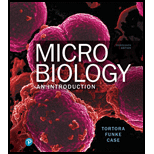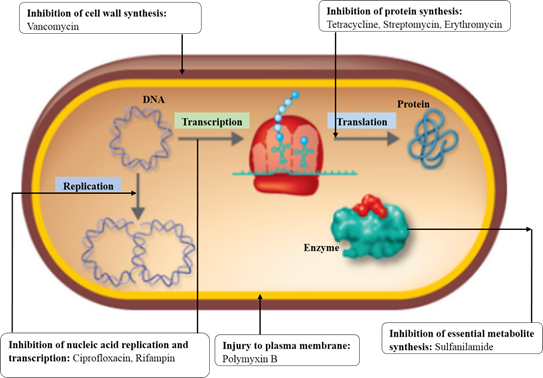
DRAW IT Show where the following antibiotics work: ciprofloxacin, tetracvcline, streptomycin, vancomycin, polymyxin B, sulfanilamide, rifampin, erythromycin.

To review:
Themode of action of given antibiotics in a bacterial cell.
Concept introduction:
The antibiotics can either act as a bacteriostatic (prevent growth of bacteria) or bactericidal (kill bacteria) agents. These drugs with a specific mode of action inhibits the essential biological processes of the target pathogen, including disruption of plasma membrane permeability, inhibition of cell wall, protein and nucleic acid synthesis, and inhibition of essential metabolites synthesis.
Answer to Problem 1R
Correct answer:
| ANTIBIOTICS | MODE OF ACTION |
| Ciprofloxacin | Inhibition of the nucleic acid replication |
| Tetracycline | Inhibition of the protein synthesis |
| Streptomycin | Inhibition of the protein synthesis |
| Vancomycin | Inhibition of the cell wall synthesis |
| Polymyxin B | Injury to the plasma membrane |
| Sulfanilamide | Inhibition of the essential metabolite synthesis |
| Rifampin | Inhibition of the nucleic acid transcription |
| Erythromycin | Inhibition of the protein synthesis |
Explanation of Solution
Diagram:

Explanation:
The mechanism of action of the given antibacterial drugs:
Ciprofloxacin – A broad spectrum of the bactericidal agent inhibits the bacterial enzyme DNA gyrase and blocks DNA synthesis. The DNA gyrase is an essential enzyme which is specifically involved in the introduction of negative supercoiling.
Tetracycline – A broad spectrum of the bacteriostatic agent prevents the attachment of aminoacyl tRNA from binding to bacterial 30S ribosome. By binding to the 30S subunit of bacterial ribosome, the tetracycline blocks the association of aminoacyl tRNA with the acceptor site.
Streptomycin – A broad spectrum of the bactericidal agent by acting on 70S ribosome inhibits the protein synthesis. It binds to the 30S subunit of bacterial ribosome and disrupts the protein synthesis (initiation and elongation step).
Vancomycin – A broad spectrum of the antibacterial agent inhibits the assembly of cell wall of bacteria. The N-acetylmuramic acid (NAG) and N-acetylglucosamine (NAM) monomers are the the building blocks of peptidoglycan cell wall. By binding to NAG and NAM, the vancomycin prevents the action of transpeptidase enzyme which is involved in the cross-linking of peptidoglycan.
Polymyxin B – A broad spectrum of the bactericidal agent with a cationic detergent action disrupts the permeability of the plasma membrane.
Sulfanilamide – A broad spectrum of the bacteriostatic agent acts as a competitive inhibitor of p-aminobenzoic acid (PABA). The sulfanilamide with a similar chemical structure competitively prevents the action of PABA and inhibits the folic acid biosynthesis. This arrests the bacterial growth and ultimately results in the elimination of the bacteria.
Rifampin – A broad spectrum of the bactericidal agent specifically inhibits the function of RNA polymerase in the bacteria. Rifampin forms a stable complex with the enzyme, thereby inhibits its activity in the nucleic acid transcription.
Erythromycin – A broad spectrum of the antibacterial agent inhibits the protein synthesis by binding to the bacterial 50S ribosome. It inhibits the activity of peptidyl transferase and intervenes with the amino acid translocation and protein assembly.
The specific site of action of the given antibacterial agents, namely cell wall synthesis (vancomycin), protein synthesis (tetracycline, streptomycin, erythromycin), essential metabolite synthesis (sulfanilamide), nucleic acid synthesis (ciprofloxacin), nucleic acid transcription (rifampin), and plasma membrane integrity (polymyxin B) is shown.
Want to see more full solutions like this?
Chapter 20 Solutions
Microbiology: An Introduction (13th Edition)
Additional Science Textbook Solutions
Laboratory Manual for Holes Human Anatomy & Physiology Fetal Pig Version
Campbell Essential Biology (7th Edition)
Principles of Anatomy and Physiology
Anatomy & Physiology
Human Physiology: An Integrated Approach (8th Edition)
Microbiology Fundamentals: A Clinical Approach - Standalone book
- For each of the following antibiotics, give the spectrum, primary effect and briefly explain the mechanism of action: 1) Penicillins 2) Po1yrrryxin B 3) Vancomycin 4) Tetracyclinsarrow_forwardConsidering having the same targets, Which of the following inhibitors are correctly grouped? A. Amytal, antimycin A, oligomycin B. Cyanide, amytal, rotenon C. Oligomycin, antimycin A, piericidine D. Carbon monoxide, azide cyanidearrow_forwardObserve the results from a disc-diffusion experiment below. Which antibiotic would you prescribe to a patient with a similar Staphylococci infection? The patient has no known allergies or contraindications for broad-spectrum antibiotics. Remember to use the table above to determine if the bacteria are resistant, susceptible or intermediate. a. Tetracycline b. Streptomycin c. Penicillin d. Norfloxacinarrow_forward
- List down the 25 different antibiotics and give the mechanism of action.arrow_forwardBased on the following image, which concentration of antibiotic would be considered the minimum bactericidal concentration (MBC)? a. 8 ug/mlb. 16 ug/mlc. 25 ug/mlarrow_forwardwhich of the following antibiotics is not bactericidal? a. vancomycin b.polymyxin b c. penicillin d. cephalosporins e. tetracyclinearrow_forward
- Cephalosporins resemble which antibiotic in their mode ofaction and their structure?(a) Penicillin(b) Bacitracin(c) Streptomycin(d) Polymyxin(e) Tetracyclinearrow_forwardComplete the table regarding antibioticsarrow_forwardDescribe five modes of action for antibiotics. For each, provide one example.arrow_forward
- Which of the following would most likely NOT be taken orally? a. Erythromycin b. Penicillin G c. Isoniazid d. Rifampinarrow_forwardDraw a diagram to illustrate the procedure for the determination of the minimum inhibitory concentration of antimicrobial agents.arrow_forwardList all the antibiotics in the above table that work through destroying the bacterial cell wall. (if there are none listed please state that)arrow_forward
- Essentials of Pharmacology for Health ProfessionsNursingISBN:9781305441620Author:WOODROWPublisher:Cengage

